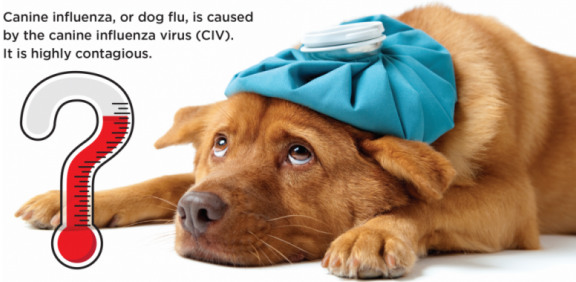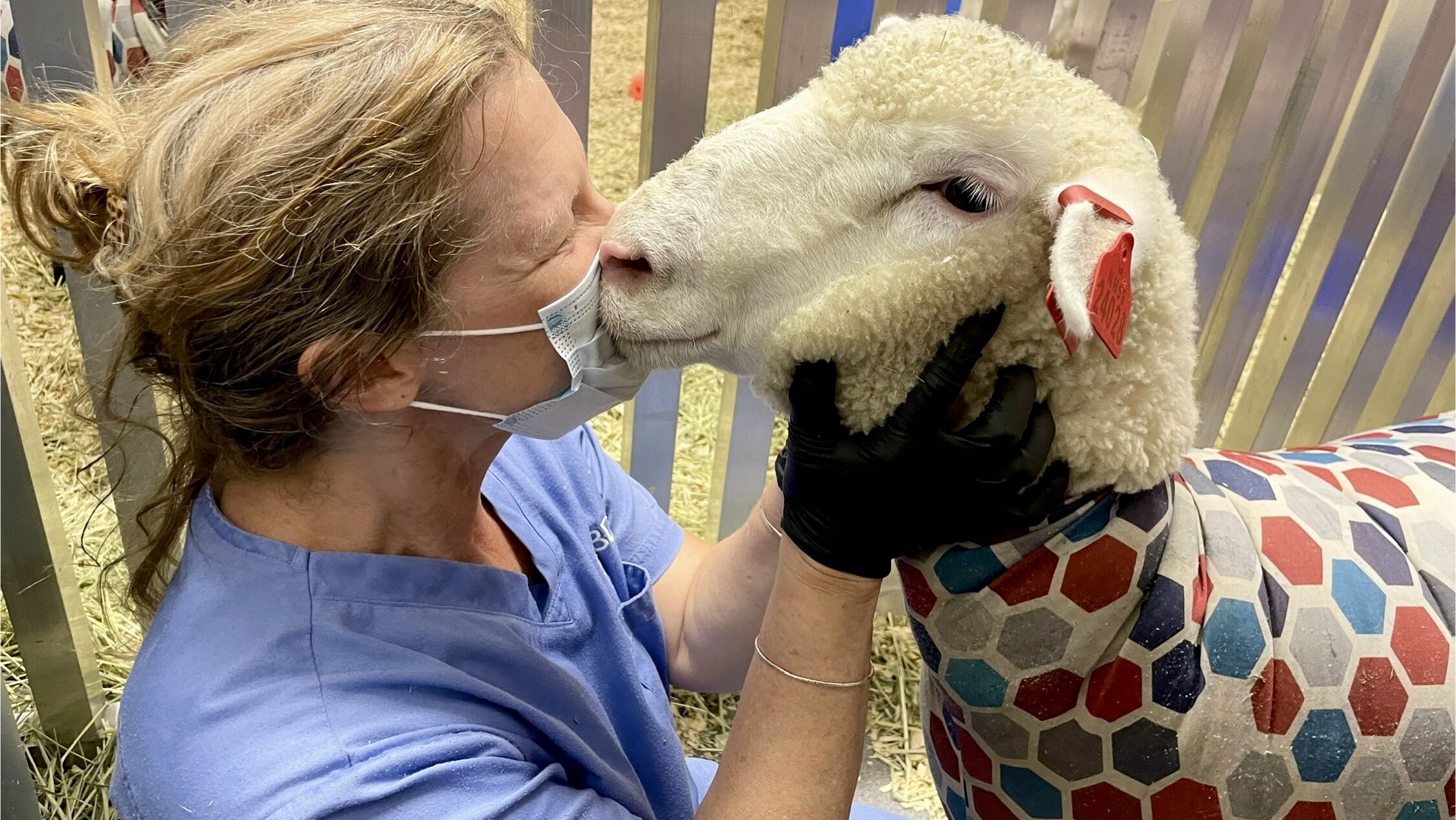Canine Influenza: Know the Facts

[section_subtitle]Canine influenza (CI, or dog flu) in the U.S. is caused by the canine influenza virus (CIV), an influenza A virus:[/section_subtitle]
- Canine influenza viruses join a number of organisms (such as Bordetella bronchiseptica, parainfluenza virus, and others) that are known to cause “kennel cough,” pneumonia, and rarely death.
- None of the vaccines available for any of the organisms that cause “kennel cough” are 100% effective, but they can be useful in decreasing severity of signs and spread of organisms.
[section_subtitle]Think of kennel cough and canine influenza as you do colds and flu in people:[/section_subtitle]
- Many different organisms and strains of organisms can be involved.
- Some people never get sick, some people get very sick, and an unfortunate few die.
- People get sick more often if their child is in daycare or school.
- Vaccines are helpful but do not offer complete protection.
- Rarely an extremely virulent organism arises that can cause widespread fatality (e.g. Pandemic flu of 1918). Thankfully, the currently circulating canine organisms are not behaving in this way.
[section_subtitle]The best prevention against any infection is avoiding exposure:[/section_subtitle]
Dogs may be shedding organisms before they show any signs of disease. We should always be cautious when our dogs are around other dogs. Good practices include:
- Avoid face to face contact between dogs
- Do not share water bowls, food bowls, or toys
- Wash your hands frequently
- Disinfect kennels between dogs
- Do NOT bring any dog to a trial, class, dog park, boarding facility or any other gathering of dogs if they are showing ANY signs of not feeling well
- Pick up feces immediately and completely
- Discuss appropriate vaccinations for your dog with your veterinarian
[section_subtitle]Protocols and Info for Referring Veterinarians[/section_subtitle]
- Protocols for puppies that have not yet been vaccinated: Puppies can be vaccinated as early as 7 weeks. They need an initial vaccine and a booster in 2-4 weeks (just like other non-previously vaccinated dogs.)
- Protocols for adult dogs that have been previously vaccinated with the regular flu strain: Will need two vaccines to get the response for the H3N2 strain
- Concurrent administration of the bivalent vaccine with other vaccines: We have not seen any vaccine reactions to date.
- Priority for vaccination: any dogs going to boarding, shows, day camps, parks. Dogs of veterinary staff that may come into contact with potential flu dogs.
- What to do for suspected cases? Treat suspected cases as soon as possible. The Veterinary Hospital does not accept referrals for canine flu.
[section_subtitle]Key Facts about Canine Influenza (Dog Flu) from the Centers for Disease Control and Prevention[/section_subtitle]
(Choose from the questions below by clicking on the title.)
[toggle] [toggle_content title=”1. What is canine influenza (dog flu)?”]Canine influenza (also known as dog flu) is a contagious respiratory disease in dogs caused by specific Type A influenza viruses known to infect dogs. These are called “canine influenza viruses.” Dog flu is a disease of dogs. No human infections with canine influenza have ever been reported. There are two different influenza A dog flu viruses: one is an H3N8 virus and the other is an H3N2 virus. [/toggle_content]
[toggle_content title=”2. Can canine influenza viruses infect humans?”]
To date, there is no evidence of transmission of canine influenza viruses from dogs to people and there has not been a single reported case of human infection with a canine influenza virus.
However, influenza viruses are constantly changing and it is possible for a virus to change so that it could infect humans and spread easily between humans. Human infections with new influenza viruses (against which the human population has little immunity) are concerning when they occur. Such viruses could present pandemic influenza threats. For this reason, CDC and its partners are monitoring the canine influenza H3N8 and H3N2 viruses (as well as other animal influenza viruses) closely. In general, canine influenza viruses are considered to pose a low threat to humans.
[/toggle_content]
[toggle_content title=”3. Where did canine influenza viruses come from and how long has it been around?”]
Canine influenza H3N8 virus originated in horses, has spread to dogs, and can now spread between dogs. The H3N8 equine influenza (horse flu) virus has been known to exist in horses for more than 40 years. In 2004, however, cases of an unknown respiratory illness in dogs (initially greyhounds) were reported in the United States. An investigation showed that this respiratory illness was caused by the equine influenza A H3N8 virus. Scientists believe this virus jumped species (from horses to dogs) and has adapted to cause illness in dogs and spread among dogs, especially those housed in kennels and shelters. This is now considered a dog-specific H3N8 virus. In September 2005, this virus was identified by experts as a “newly emerging pathogen in the dog population” in the United States.
The H3N2 canine influenza virus is an avian flu virus that adapted to infect dogs. This virus is different from human seasonal H3N2 viruses. Canine influenza A H3N2 virus was first detected in dogs in South Korea in 2007. This virus seems to have been an avian influenza virus that adapted to infect dogs and has since been reported in China and Thailand. H3N2 canine influenza has reportedly infected some cats as well as dogs. It was first detected in the United States in April 2015. The canine H3N2 virus is genetically different from human seasonal H3N2 viruses. It is not known how canine H3N2 virus was introduced into the United States.
[/toggle_content]
[toggle_content title=”4. What are signs of canine influenza infection in dogs?”]
The signs of this illness in dogs are cough, runny nose, and fever, but not all dogs will show signs of illness. The severity of illness associated with canine flu in dogs can range from no signs to severe illness resulting in pneumonia and sometimes death.
[/toggle_content]
[toggle_content title=”5. How serious is canine influenza infection in dogs?”]
The percentage of dogs infected with this disease that die is very small. Some dogs have asymptomatic infections (no signs of illness), while some have severe infections. Severe illness is characterized by the onset of pneumonia. This is a relatively new cause of disease in dogs and nearly all dogs are susceptible to infection. [/toggle_content]
[toggle_content title=”6. How is canine influenza spread?”]Almost all dogs are susceptible to canine flu infection, and illness tends to spread among dogs housed in kennels and shelters. Canine flu can spread to other dogs by direct contact with aerosolized respiratory secretions (coughing and sneezing) from infected dogs, by uninfected dogs coming into contact with contaminated objects, and by moving contaminated objects or materials between infected and uninfected dogs. Therefore, dog owners whose dogs are coughing or showing other signs of respiratory disease should not expose their dog to other dogs. Clothing, equipment, surfaces, and hands should be cleaned and disinfected after exposure to dogs showing signs of respiratory disease.
[/toggle_content]
[toggle_content title=”7. Is there a test for canine influenza?”]Testing to confirm canine influenza virus infection in dogs is available. Your veterinarian can tell you if testing is appropriate. [/toggle_content]
[toggle_content title=”8. How is canine influenza infection in dogs treated?”]Treatment largely consists of supportive care. This helps the dog mount an immune response. In the milder form of the disease, this care may include medication to make your dog more comfortable and fluids to ensure that your dog remains well-hydrated. Broad spectrum antibiotics may be prescribed by your veterinarian if a secondary bacterial infection is suspected. [/toggle_content]
[toggle_content title=”9. Is there a vaccine for canine influenza?”]The current flu strain is the H3N2. The H3N8 vaccine is not proven to protect agains the H3N2 strain. We recommend people vaccinate for either H3N2 or vaccinate agains both strains (called the bivalent) vaccine. [/toggle_content]
[toggle_content title=”10. My dog has a cough. What should I do?”]Schedule an appointment with your veterinarian so they can evaluate your dog and recommend an appropriate course of treatment. [/toggle_content]
[toggle_content title=”11. Where can I find more information on canine influenza virus?”]More information on canine influenza in pet dogs can be found in this article: Influenza A Virus (H3N8) in Dogs with Respiratory Disease, Florida in Emerging Infectious Diseases journal, the AVMA website, and this update on the April 2015 Chicago H3N2 canine influenza outbreak. [/toggle_content]
[toggle_content title=”12. References”]
- Media Briefing on Canine Influenza. September 25, 2005. http://www.cdc.gov/media/transcripts/t050926.htm.
- Update on Canine Influenza (Dog Flu) Outbreak Reported in Chicago Area. April 13, 2015. http://www.cdc.gov/flu/news/canine-influenza-update.htm.
- Influenza A Virus (H3N8) in Dogs with Respiratory Disease, Florida. Volume 14, Number 6 – June 2008. http://wwwnc.cdc.gov/eid/article/14/6/07-1270_article.
- Canine influenza. https://www.avma.org/KB/Resources/Reference/Pages/Canine-Influenza-Backgrounder.aspx
[/toggle_content]
[/toggle]
[document id=”67011″]
- Categories:


